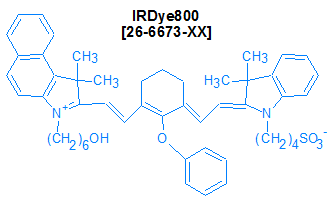
Modification : IRDye 800RS-N
Catalog Reference Number
Category
Modification Code
5 Prime
3 Prime
Internal
Molecular Weight (mw)
Extinction Coeficient (ec)
Technical Info (pdf)
Absorbance MAX
Emission MAX
Absorbance EC
26-6767
Fluorescent Dyes
[IRD800RS-N]
Y
Y
Y
864
200
PS26-6767.pdf
767
786
170
| Catalog No | Scale | Price |
| 26-6767-05 | 50 nmol | $828.00 |
| 26-6767-02 | 200 nmol | $828.00 |
| 26-6767-01 | 1 umol | $1,685.00 |
| 26-6767-03 | 2 umol | $3,082.00 |
| 26-6767-06 | 5 umol | $4,432.50 |
| 26-6767-10 | 10 umol | $7,880.00 |
| 26-6767-15 | 15 umol | $9,850.00 |
Click here for a list of fluorophores.
This modification is a post synthesis conjugation to a primary amino group thus an additional modification with an amino group is required. A C3, C6 or C12 amino group can be placed at the 5' or for the 3' end a C3 or C7 amino and for internal positions an amino modified base is used, e.g Amino dT C6.
IRDye series of dyes are near-IR fluorescent dye used for labeling oligonucleotides. IRDye800 has an absorbance maximum of 767 nm and an emission maximum of 786 nm. The combination of narrow absorbance/emission bands and low-background autofluorescence in the IR region results in higher S/N ratios and thus enhanced detection sensitivity compared with fluorophores with absorbance/emission maxima in the visible region (1).
IRDye800 can be used to label DNA oligos for use as hybridization probes in a variety of in vivo and in vitro research or diagnostic applications, as well as for structure-function studies of DNA, RNA, and protein-oligonucleotide complexes. Oligos labeled with IRDye800 at the 5’-end can be used as PCR and Sanger DNA sequencing primers to generate fluorescently-labeled PCR, sequencing or genetic analysis (AFLP, microsatellite) products (3-5).
|
Near Infrared Fluorophore Spectral Data & Quencher Selection Guide
|
|
Fluorophore Name
|
Absorbance Max, nm +/-10
|
Emission Max, nm +/-10
|
Extinction Coefficient*
|
Color**
|
Quencher
|
Cy5 |
650 |
665 |
250,000 |
Human vision is insensitive to light beyond ~650 nm. |
BBQ-650 λ (max) = 650nm Range = 550-750 nm |
IRDye 650 NHS |
650 |
665 |
230,000 |
Human vision is insensitive to light beyond ~650 nm. |
BBQ-650 λ (max) = 650nm Range = 550-750 nm |
AZ647 NHS |
655 |
680 |
191,800 |
Human vision is insensitive to light beyond ~650 nm. |
BBQ-650 λ (max) = 650nm Range = 550-750 nm |
AZ680 NHS |
678 |
701 |
185,000 |
Human vision is insensitive to light beyond ~650 nm. |
BBQ-650 λ (max) = 650nm Range = 550-750 nm |
Cy5.5 |
684 |
710 |
198,000 |
Human vision is insensitive to light beyond ~650 nm. |
BBQ-650 λ (max) = 650nm Range = 550-750 nm |
IRDye 700 NHS |
684 |
710 |
288,000 |
Human vision is insensitive to light beyond ~650 nm. |
BBQ-650 λ (max) = 650nm Range = 550-750 nm |
AZdye700 NHS |
696 |
719 |
192,000 |
Human vision is insensitive to light beyond ~650 nm. |
BBQ-650 λ (max) = 650nm Range = 550-750 nm |
Atto 700 NHS |
700 |
716 |
120,000 |
Human vision is insensitive to light beyond ~650 nm. |
BBQ-650 λ (max) = 650nm Range = 550-750 nm |
Atto 725 NHS |
728 |
751 |
120,000 |
Human vision is insensitive to light beyond ~650 nm. |
BBQ-650 λ (max) = 650nm Range = 550-750 nm |
Atto 740 NHS |
743 |
763 |
120,000 |
Human vision is insensitive to light beyond ~650 nm. |
BBQ-650 λ (max) = 650nm Range = 550-750 nm |
Cy7 NHS |
740 |
773 |
199,000 |
Human vision is insensitive to light beyond ~650 nm. |
BBQ-650 λ (max) = 650nm Range = 550-750 nm |
IRDye 750 NHS |
756 |
776 |
260,000 |
Human vision is insensitive to light beyond ~650 nm. |
BBQ-650 λ (max) = 650nm Range = 550-750 nm |
cy7.5 NHS |
788 |
808 |
223,000 |
Human vision is insensitive to light beyond ~650 nm. |
BBQ-650 λ (max) = 650nm Range = 550-750 nm |
IRDye 800 NHS |
795 |
819 |
240,000 |
Human vision is insensitive to light beyond ~650 nm. |
BBQ-650 λ (max) = 650nm Range = 550-750 nm |
|
* Extinction coefficient at λ (max) in cm-1M-1. ** Typical emission color seen through the eyepiece of a conventional fluorescence microscope with appropriate filters. Near-IR region. Human vision is insensitive to light beyond ~650 nm; it is not possible to view near-IR fluorescent dyes.
Click here for a list of fluorophores.
|
|
Click here for list of quenchers.
|
References
1. Middendorf, L.R., Bruce, J.C., Eckles, R.D., Grone, D.L., Roemer, S.C., Sloniker, G.D., Steffens, D.L., Sutter, S.L., Brumbaugh, J.A., et al. Continuous, on-line DNA sequencing using a versatile infrared laser scanner/electrophoresis apparatus.
Electrophoresis (1992),
13: 487-494.
2. Peng X., Chen, H., Draney, D.R., Volcheck, W., Schutz-Geschwender, A., Olive, D.M. A nonfluorescent, broad-range quencher dye for Forster resonance energy transfer assays.
Anal. Biochem. (2009),
388: 220-228.
3. Yomano, L.P., Scopes, R.K., Ingram, L.O. Cloning, sequencing, and expression of the Zymomonas mobilis phosphoglycerate mutase gene (pgm) in Escherichia coli.
J. Bacteriol. (1993),
175: 3926-3933.
4. Oetting, W.S., Lee, H.K., Flanders, D.J., Wiesner, T.A., King, R.A. Linkage Analysis with Multiplexed Short Tandem Repeat Polymorphisms Using Infrared Fluorescence and M13 Tailed Primers.
Genomics (1995),
30: 450-458.
5. Myburg, A.A., Remington, D.L, O’Malley, D.M., Sederoff, R.R., Whetton, R.W. High-Throughput AFLP Analysis Using Infrared Dye-Labeled Primers and an Automated DNA Sequencer.
Biotechniques (2001),
30: 348-357.
- IRDye 800-NHS
